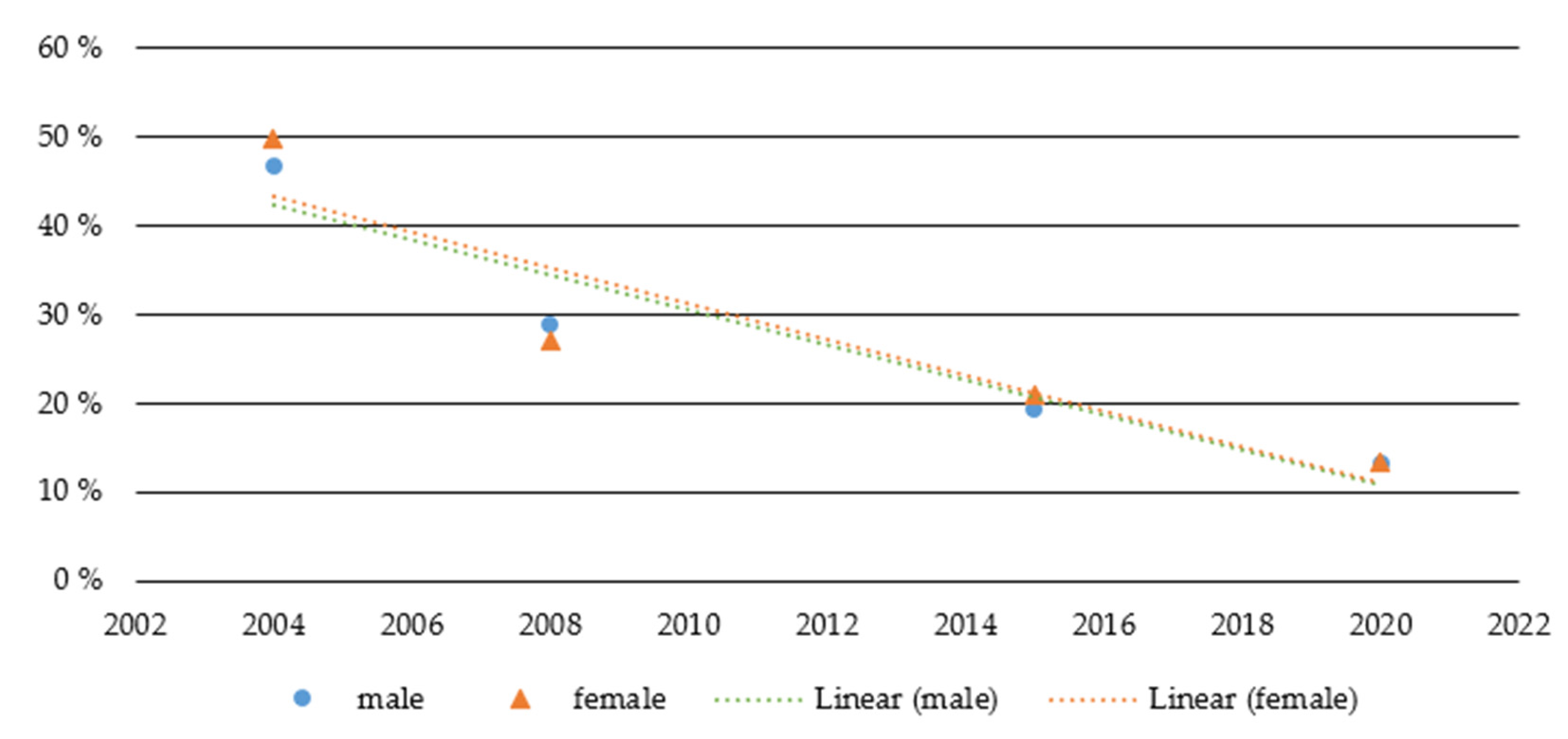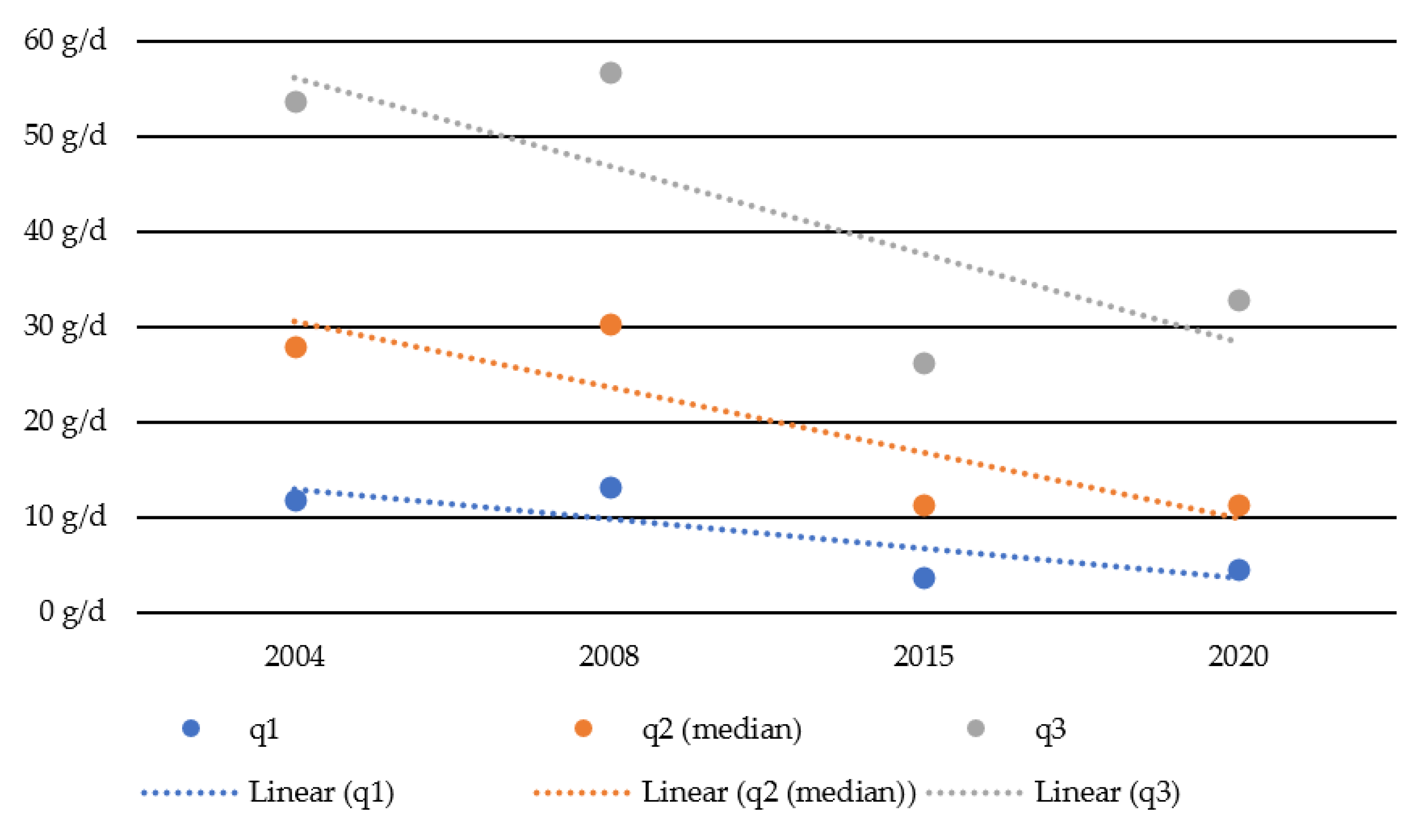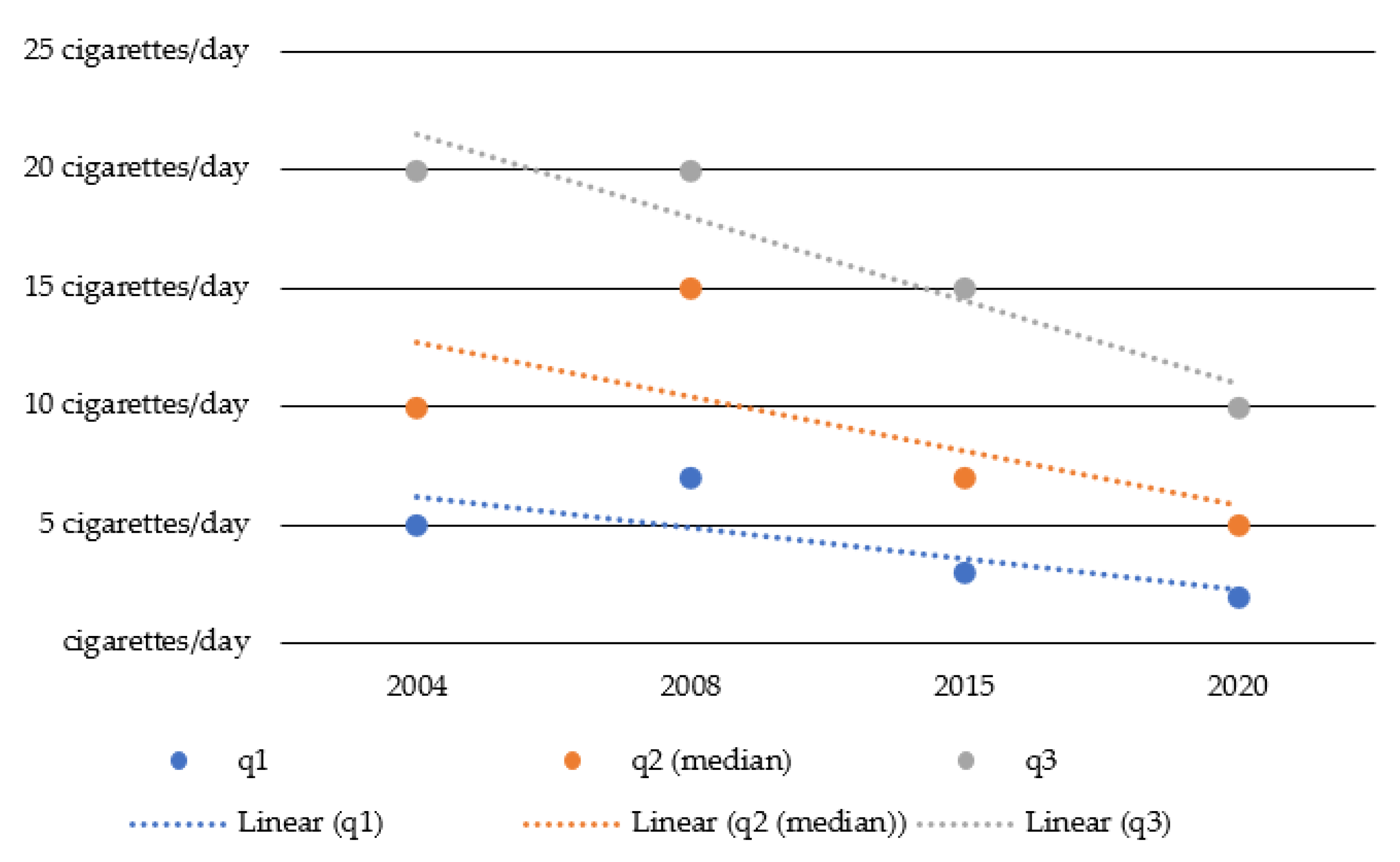Alcohol and Cigarette Use among Adolescents and Young Adults in Austria from 2004–2020: Patterns of Change and Associations with Socioeconomic Variables
Abstract
1. Introduction
2. Materials and Methods
2.1. Data Sources
2.2. Target Group and Weighting
2.3. Measures
2.4. Analyses
3. Results
3.1. Changes in Alcohol and Nicotine Consumption between 2004 and 2020
3.2. Trends for Different Levels of Consumption
3.3. Associations between Socieconomic Variables and Alcohol per Capita Consumption or Daily Smoking
4. Discussion
5. Limitations
6. Conclusions
Author Contributions
Funding
Institutional Review Board Statement
Informed Consent Statement
Data Availability Statement
Conflicts of Interest
References
- Rehm, J.; Gmel, G.E., Sr.; Gmel, G.; Hasan, O.S.M.; Imtiaz, S.; Popova, S.; Probst, C.; Roerecke, M.; Room, R.; Samokhvalov, A.V.; et al. The relationship between different dimensions of alcohol use and the burden of disease—An update. Addiction 2017, 112, 968–1001. [Google Scholar] [CrossRef]
- Olusanya, B.O.; Ştefan, S.; Kim, Y.; Alcalde-Rabanal, J.E.; Akinyemiju, T.; Koyanagi, A.; Cohen, A.J.; Wondmieneh, A.B.; De Leo, D.; Ippolito, H.; et al. Global burden of 87 risk factors in 204 countries and territories, 1990–2019: A systematic analysis for the Global Burden of Disease Study 2019. Lancet 2019, 396, 1223–1249. [Google Scholar]
- Bühler, A.; Thrul, J. Prevention of Addictive Behaviours: Updated and Expanded Edition of Prevention of Substance Abuse; EMCDDA Insights No 7; Publications Office of the European Union: Luxembourg, 2015. [Google Scholar]
- Suchtvorbeugung, A. Österreichische ARGE Suchtvorbeugung. 2021. Available online: https://www.suchtvorbeugung.net/ (accessed on 5 December 2021).
- ESPAD Group. ESPAD Report 2019: Results from the European School Survey Project on Alcohol and Other Drugs; European School Survey Project on Alcohol and Other Drugs: Lisbon, Portugal, 2020. [Google Scholar]
- Inchley, J.C.; Currie, D.B.; Vieno, A.; Torsheim, T.; Ferreira-Borges, C.; Weber, M.; Barnekow, V.; Breda, J. Adolescent Alcohol-Related Behaviours: Trends and Inequalities in the WHO European Region, 2002–2014; WHO Regional Office for Europe: København, Denmark, 2018. [Google Scholar]
- Looze, M.D.; Raaijmakers, Q.; Bogt, T.T.; Bendtsen, P.; Farhat, T.; Ferreira, M.; Godeau, E.; Kuntsche, E.; Molcho, M.; Pförtner, T.K.; et al. Decreases in adolescent weekly alcohol use in Europe and North America: Evidence from 28 countries from 2002 to 2010. Eur. J. Public Health 2015, 25 (Suppl. S2), 69–72. [Google Scholar] [CrossRef] [PubMed]
- Kraus, L.; Seitz, N.N.; Piontek, D.; Molinaro, S.; Siciliano, V.; Guttormsson, U.; Arpa, S.; Monshouwer, K.; Leifman, H.; Vicente, J.; et al. ‘Are the times A-changin’? Trends in adolescent substance use in Europe. Addiction 2018, 113, 1317–1332. [Google Scholar] [CrossRef]
- Pennay, A.; Holmes, J.; Törrönen, J.; Livingston, M.; Kraus, L.; Room, R. Researching the decline in adolescent drinking: The need for a global and generational approach. Drug Alcohol Rev. 2018, 37, S115–S119. [Google Scholar] [CrossRef] [PubMed]
- Pape, H.; Rossow, I.; Brunborg, G.S. Adolescents drink less: How, who and why? A review of the recent research literature. Drug Alcohol Rev. 2018, 37, S98–S114. [Google Scholar] [CrossRef]
- Hojni, M.; Delcour, J.; Strizek, J.; Uhl, A. ESPAD Österreich; Forschungsbericht; Gesundheit Österreich: Vienna, Austria, 2019. [Google Scholar]
- Bachmayer, S.; Strizek, J.; Uhl, A. Handbuch Alkohol—Österreich: Band 1—Statistiken und Berechnungsgrundlagen; Gesundheit Österreich GmbH: Vienna, Austria, 2020. [Google Scholar]
- Twenge, J.M.; Park, H. The decline in adult activities among US adolescents, 1976–2016. Child Dev. 2019, 90, 638–654. [Google Scholar] [CrossRef]
- Kraus, L.; Room, R.; Livingston, M.; Pennay, A.; Holmes, J.; Törrönen, J. Long waves of consumption or a unique social generation? Exploring recent declines in youth drinking. Addict. Res. Theory 2019, 28, 183–193. [Google Scholar] [CrossRef]
- Törrönen, J.; Roumeliotis, F.; Samuelsson, E.; Kraus, L.; Room, R. Why are young people drinking less than earlier? Identifying and specifying social mechanisms with a pragmatist approach. Int. J. Drug Policy 2019, 64, 13–20. [Google Scholar] [CrossRef]
- Månsson, J.; Samuelsson, E.; Törrönen, J. Doing adulthood—Doing alcohol: What happens when the ‘sober generation’ grows up? J. Youth Stud. 2020. [Google Scholar] [CrossRef]
- Gale, M.S.; Lenardson, M.H.S.; Lambert, J.D.; Hartley, M.H.A. Adolescent Alcohol Use: Do Risk and Protective Factors Explain Rural-Urban Differences? Maine Rural Health Research Center: Portland, ME, USA, 2012. [Google Scholar]
- Martin, G.; Inchley, J.; Marshall, A.; Shortt, N.; Currie, C. The neighbourhood social environment and alcohol use among urban and rural Scottish adolescents. Int. J. Public Health 2018, 64, 95–105. [Google Scholar] [CrossRef]
- Cronk, C.E.; Sarvela, P.D. Alcohol, tobacco, and other drug use among rural/small town and urban youth: A secondary analysis of the monitoring the future data set. Am. J. Public Health 1997, 87, 760–764. [Google Scholar] [CrossRef] [PubMed]
- DeHaan, L.; Boljevac, T. Alcohol prevalence and attitudes among adults and adolescents: Their relation to early adolescent alcohol use in rural communities. J. Child Adolesc. Subst. Abuse 2010, 19, 223–243. [Google Scholar] [CrossRef] [PubMed]
- Donath, C.; Gräßel, E.; Baier, D.; Pfeiffer, C.; Karagülle, D.; Bleich, S.; Hillemacher, T. Alcohol consumption and binge drinking in adolescents: Comparison of different migration backgrounds and rural vs. urban residence—A representative study. BMC Public Health 2011, 11, 84. [Google Scholar] [CrossRef] [PubMed]
- Warren, J.C.; Smalley, K.B.; Barefoot, K.N. Recent alcohol, tobacco, and substance use variations between rural and urban middle and high school students. J. Child Adolesc. Subst. Abuse 2017, 26, 60–65. [Google Scholar] [CrossRef]
- Skog, O.J. The collectivity of drinking cultures: A theory of the distribution of alcohol consumption. Br. J. Addict. 1985, 80, 83–99. [Google Scholar] [CrossRef]
- Hallgren, M.; Leifman, H.; Andréasson, S. Drinking less but greater harm: Could polarized drinking habits explain the divergence between alcohol consumption and harms among youth? Alcohol Alcohol. 2012, 47, 581–590. [Google Scholar] [CrossRef][Green Version]
- Loy, J.K.; Seitz, N.-N.; Bye, E.K.; Raitasalo, K.; Soellner, R.; Törrönen, J.; Kraus, L. Trends in alcohol consumption among adolescents in Europe: Do changes occur in concert? Drug Alcohol Depend. 2021, 228, 109020. [Google Scholar] [CrossRef] [PubMed]
- WHO. WHO Global Report on Trends in Prevalence of Tobacco Use 2000–2025; World Health Organization: Geneva, Switzerland, 2019. [Google Scholar]
- Feliu, A.; Filippidis, F.T.; Joossens, L.; Fong, G.T.; Vardavas, C.; Baena, A.; Castellano, Y.; Martinez, C.; Fernández, E. Impact of tobacco control policies on smoking prevalence and quit ratios in 27 European Union countries from 2006 to 2014. Tob. Control 2018, 28, 101–109. [Google Scholar]
- Currie, L.M.; Blackman, K.; Clancy, L.; Levy, D.T. The effect of tobacco control policies on smoking prevalence and smoking-attributable deaths in Ireland using the IrelandSS simulation model. Tob. Control 2013, 22, e25–e32. [Google Scholar] [CrossRef] [PubMed]
- Schmutterer, I. Tabak- und Verwandte Erzeugnisse: Zahlen und Fakten 2020; Gesundheit Österreich: Vienna, Austria, 2020. [Google Scholar]
- Pförtner, T.-K.; Hublet, A.; Schnohr, C.W.; Rathmann, K.; Moor, I.; de Looze, M.; Baška, T.; Molcho, M.; Kannas, L.; Kunst, A.E.; et al. Socioeconomic inequalities in the impact of tobacco control policies on adolescent smoking. A multilevel study in 29 European countries. Addict. Behav. 2016, 53, 58–66. [Google Scholar] [CrossRef]
- Hublet, A.; Schmid, H.; Clays, E.; Godeau, E.; Nic Gabhainn, S.; Joossens, L.; Maes, L.; The HBSC Research Network. Association between tobacco control policies and smoking behaviour among adolescents in 29 European countries. Addiction 2009, 104, 1918–1926. [Google Scholar] [CrossRef]
- Fadus, M.C.; Smith, T.T.; Squeglia, L.M. The rise of e-cigarettes, pod mod devices, and JUUL among youth: Factors influencing use, health implications, and downstream effects. Drug Alcohol Depend. 2019, 201, 85–93. [Google Scholar] [CrossRef]
- Hallingberg, B.; Maynard, O.M.; Bauld, L.; Brown, R.; Gray, L.; Lowthian, E.; MacKintosh, A.-M.; Moore, L.; Munafo, M.R.; Moore, G. Have e-cigarettes renormalised or displaced youth smoking? Results of a segmented regression analysis of repeated cross sectional survey data in England, Scotland and Wales. Tob. Control 2019, 29, 207–216. [Google Scholar] [CrossRef]
- Hiscock, R.; Bauld, L.; Amos, A.; Fidler, J.A.; Munafo, M. Socioeconomic status and smoking: A review. Ann. N. Y. Acad. Sci. 2011, 1248, 107–123. [Google Scholar] [CrossRef]
- Thirlway, F. Explaining the social gradient in smoking and cessation: The peril and promise of social mobility. Sociol. Health Illn. 2019, 42, 565–578. [Google Scholar] [CrossRef]
- Klimont, J.; Prammer-Waldhör, M. Soziodemographische und Sozioökonomische Determinanten von Gesundheit; Statistik: Vienna, Austria, 2020. [Google Scholar]
- Holstein, B.; Andersen, A.; Damsgaard, M.T.; Due, P.; Bast, L.S.; Rasmussen, M. Trends in socioeconomic differences in daily smoking among 15-year-old Danes 1991–2014. Scand. J. Public Health 2019, 48, 667–673. [Google Scholar] [CrossRef] [PubMed]
- Urban, M.; Burghuber, O.; Dereci, C.; Aydogan, M.; Selimovic, E.; Catic, S.; Funk, G.-C. Tobacco addiction and smoking cessation in Austrian migrants: A cross-sectional study. BMJ Open 2015, 5, e006510. [Google Scholar] [CrossRef]
- Uhl, A.; Strizek, J. Österreichweite Repräsentativerhebung zu Substanzgebrauch. Erhebung 2004. Bericht; Bundesministerium für Gesundheit und Frauen: Vienna, Austria, 2005; p. 169. [Google Scholar]
- Uhl, A.; Strizek, J.; Puhm, A.; Kobrna, U.; Springer, A. Österreichweite Repräsentativerhebung zu Substanzgebrauch. Band 1: Forschungsbericht; Bundesministerium für Gesundheit: Vienna, Austria, 2009; p. 71. [Google Scholar]
- Strizek, J.; Uhl, A. Bevölkerungserhebung zu Substanzgebrauch. Band 1: Forschungsbericht; Gesundheit Österreich: Vienna, Austria, 2016. [Google Scholar]
- EMCDDA. Handbook for Surveys on Drug Use Among the General Population; EMCDDA project CT.99.EP.08 B.; EMCDDA: Lisbon, Portugal, 2002. [Google Scholar]
- Moskalewicz, J.; Room, R.; Thom, B. (Eds.) Comparative Monitoring of Alcohol Epidemiology Across the EU. Baseline Assessment and Suggestions for Future Action—Synthesis Report; PARPA—The State Agency for Prevention of Alcohol Related Problems: Warsaw, Poland, 2016; p. 368. [Google Scholar]
- Kalinowski, A.; Humphreys, K. Governmental standard drink definitions and low-risk alcohol consumption guidelines in 37 countries. Addiction 2016, 111, 1293–1298. [Google Scholar] [CrossRef] [PubMed]
- Uhl, A.; Strizek, J.; Hojni, M. Handbuch Alkohol Österreich. Band 3: Ausgewählte Themen; Gesundheit Österreich: Vienna, Austria, 2020. [Google Scholar]
- Das, A.; Singh, P.; Bruckner, T.A. State lockdown policies, mental health symptoms, and using substances. Addict. Behav. 2021, 124, 107084. [Google Scholar] [CrossRef] [PubMed]
- Bambra, C.; Riordan, R.; Ford, J.; Matthews, F. The COVID-19 pandemic and health inequalities. J. Epidemiol. Commun. Health 2020, 74, 964–968. [Google Scholar] [CrossRef] [PubMed]




| Subgroup | 2004 | 2008 | 2015 | 2020 | Change Rate 2004–2020 1 | Interaction Term (Eta Square) |
|---|---|---|---|---|---|---|
| Total | 27 | 23 | 22 | 13 | −54% | - |
| Sex | ||||||
| Males | 34 | 30 | 26 | 15 | −55% | 0.003 ** |
| Females | 20 | 15 | 17 | 10 | −51% | |
| Educational level * | ||||||
| Lower level of education | 32 | 23 | 28 | 17 | −45% | 0.001 |
| Higher level of education | 34 | 23 | 22 | 14 | −60% | |
| Employment status * | ||||||
| Working | 34 | 23 | 28 | 16 | −51% | 0.003 ** |
| In education | 35 | 30 | 22 | 13 | −62% | |
| Place of residence | ||||||
| Rural | 29 | 24 | 28 | 16 | −47% | 0.001 |
| Urban | 26 | 21 | 19 | 12 | −53% |
| Subgroup | 2004 | 2008 | 2015 | 2020 | Change Rate 2004–2020 1 | Interaction Term (Eta Square) |
|---|---|---|---|---|---|---|
| Total | 48.2% | 28.0% | 20.1% | 13.3% | −72.5% | |
| Sex | ||||||
| Male | 46.8% | 28.9% | 19.3% | 13.3% | −71.6% | 0.000 |
| Female | 49.7% | 27.1% | 20.9% | 13.3% | −73.2% | |
| Educational level * | ||||||
| Lower level of education | 64.5% | 38.0% | 37.0% | 29.6% | −54.1% | 0.001 |
| Higher level of education | 39.6% | 21.6% | 15.5% | 10.6% | −73.2% | |
| Employment status * | ||||||
| Working | 57.1% | 32.9% | 26.5% | 18.9% | −67.0% | 0.005 ** |
| In education | 31.4% | 14.1% | 17.7% | 7.4% | −76.3% | |
| Place of residence | ||||||
| Rural | 50.8% | 27.8% | 21.5% | 11.7% | −77.1% | 0.001 |
| Urban | 46.3% | 28.2% | 19.2% | 13.8% | −70.3% |
| Independent Variable | Model | R | R2 | Change in R2 | Change in F | Sig. Change in F |
|---|---|---|---|---|---|---|
| Alcohol per capita consumption | Model 1 | 0.151 | 0.021 | 0.023 | 17.989 | 0.000 |
| Model 2 | 0.239 | 0.054 | 0.034 | 21.153 | 0.000 | |
| −2 Log-Likelihood | Cox & Snell R2 | Nagelkerkes R2 | ||||
| Daily smoking | Model 1 | 2653.5 | 0.064 | 0.091 | ||
| Model 2 | 2528.0 | 0.113 | 0.161 |
| Model | Predictors | B | Stand. Error | Beta | T | sig. |
|---|---|---|---|---|---|---|
| Model 1 | Constant | 34.14 | 1.84 | 18.52 | 0.00 | |
| Survey year 2008 | −9.84 | 2.30 | −0.12 | −4.27 | 0.00 | |
| Survey year 2015 | −8.67 | 2.70 | −0.08 | −3.22 | 0.00 | |
| Survey year 2020 | −18.84 | 2.57 | −0.19 | −7.33 | 0.00 | |
| Model 2 | Constant | 61.83 | 4.90 | 12.61 | 0.00 | |
| Survey year 2008 | −10.34 | 2.29 | −0.12 | −4.52 | 0.00 | |
| Survey year 2015 | −8.17 | 2.66 | −0.08 | −3.08 | 0.00 | |
| Survey year 2020 | −17.55 | 2.56 | −0.18 | −6.87 | 0.00 | |
| Sex | −14.86 | 1.69 | −0.18 | −8.81 | 0.00 | |
| Educational level | −1.13 | 1.92 | −0.01 | −0.59 | 0.56 | |
| Employment status | 1.45 | 1.99 | 0.02 | 0.73 | 0.46 | |
| Place of residence | −3.80 | 1.75 | −0.05 | −2.17 | 0.03 |
| Model | Predictors | B | Stand. Error | Wald | df | sig. | exp(B) |
|---|---|---|---|---|---|---|---|
| Model 1 | Constant | 3.71 | 0.26 | 211.6 | 1 | 0.00 | 40.84 |
| Survey year 2008 | −0.77 | 0.12 | 44.6 | 1 | 0.00 | 0.46 | |
| Survey year 2015 | −1.14 | 0.14 | 62.2 | 1 | 0.00 | 0.32 | |
| Survey year 2020 | −1.71 | 0.15 | 125.7 | 1 | 0.00 | 0.18 | |
| Model 2 | Constant | 4.53 | 0.29 | 238.8 | 1 | 0.00 | 92.54 |
| Survey year 2008 | −0.99 | 0.12 | 64.7 | 1 | 0.00 | 0.37 | |
| Survey year 2015 | −1.15 | 0.15 | 59.1 | 1 | 0.00 | 0.32 | |
| Survey year 2020 | −1.65 | 0.16 | 109.5 | 1 | 0.00 | 0.19 | |
| Sex | 0.08 | 0.10 | 0.7 | 1 | 0.39 | 1.09 | |
| Educational level | −0.79 | 0.11 | 54.0 | 1 | 0.00 | 0.45 | |
| Employment status | −0.64 | 0.13 | 25.2 | 1 | 0.00 | 0.53 | |
| Place of residence | 0.04 | 0.10 | 0.2 | 1 | 0.68 | 1.04 |
Publisher’s Note: MDPI stays neutral with regard to jurisdictional claims in published maps and institutional affiliations. |
© 2021 by the authors. Licensee MDPI, Basel, Switzerland. This article is an open access article distributed under the terms and conditions of the Creative Commons Attribution (CC BY) license (https://creativecommons.org/licenses/by/4.0/).
Share and Cite
Strizek, J.; Uhl, A.; Schaub, M.; Malischnig, D. Alcohol and Cigarette Use among Adolescents and Young Adults in Austria from 2004–2020: Patterns of Change and Associations with Socioeconomic Variables. Int. J. Environ. Res. Public Health 2021, 18, 13080. https://doi.org/10.3390/ijerph182413080
Strizek J, Uhl A, Schaub M, Malischnig D. Alcohol and Cigarette Use among Adolescents and Young Adults in Austria from 2004–2020: Patterns of Change and Associations with Socioeconomic Variables. International Journal of Environmental Research and Public Health. 2021; 18(24):13080. https://doi.org/10.3390/ijerph182413080
Chicago/Turabian StyleStrizek, Julian, Alfred Uhl, Michael Schaub, and Doris Malischnig. 2021. "Alcohol and Cigarette Use among Adolescents and Young Adults in Austria from 2004–2020: Patterns of Change and Associations with Socioeconomic Variables" International Journal of Environmental Research and Public Health 18, no. 24: 13080. https://doi.org/10.3390/ijerph182413080
APA StyleStrizek, J., Uhl, A., Schaub, M., & Malischnig, D. (2021). Alcohol and Cigarette Use among Adolescents and Young Adults in Austria from 2004–2020: Patterns of Change and Associations with Socioeconomic Variables. International Journal of Environmental Research and Public Health, 18(24), 13080. https://doi.org/10.3390/ijerph182413080






